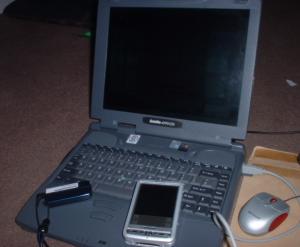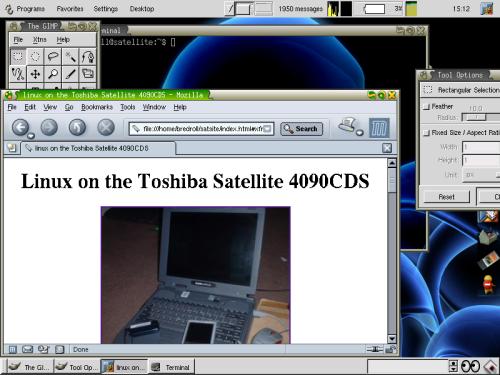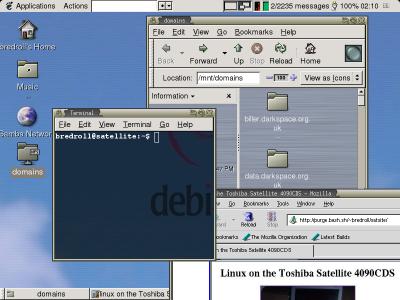Linux on the Toshiba Satellite 4090CDS and Portege 7220

Satellite 4090CDS Specs:
Intel PII Celeron 400Mhz
128Mb RAM
30Gb IBM Travelstar IDE
1xUSB
IrDA
RS232+Parallel
Toshiba Laptop IDE DVD Drive (extra Jan-03)
Portege 7220 Specs:
Intel PIII Coppermine 650MHz (has speedstep but doesnt work in linux yet)
128Mb RAM
30Gb IBM Travelstar IDE
1xUSB
IrDA
RS232+Parallel via external dongle
Floppy via external drive
Contents
Update
I have now (jan 2005) sold the Satellite, It was a good machine, I'll miss it in a geeky sort of way as it was my first 'decent' laptop. I now have my fiance's old portege 7220 and it is fantastic. Just enough performance to play quake2 on the move and do pretty much any work and programming I need. I recently purchased a 6000mAh battery for it and can easily work for 4hrs or more on battery!
See below for a fix for the bad sound when on battery for both the portege 7220 and satellite 4090.
The Portege and Satellite are able to use kernel 2.4.26 without any problems.
On a note with the graphics, I had briefly spoken with the maintainer of the trident driver for XFree86, he says he DOES have plans to complete the multihead support for the card (al-a win98) but not just yet.
*note* - most of this (except the s3 sound card) is identical to getting debian running on a Toshiba Portege' 7220/7200. I infact now have this very same installation running on my portege without ill affects. Obviously you should 'really' compile support for the PIII chip and the AGP bus in the portege too.
The portege runs very well in Linux 2.6.12-rc3 with APM instead of ACPI. (ACPI suspend to ram [S3] doesnt wake up the pcmcia devices correctly). Obviously, not owning the Satellite any longer I cant test this.
Thankfully this laptop has a cdrom, if you hold down F1 and Esc at power on it gets upset and asks you to press [F1], this takes you to the tsetup bios program, you can run it from dos but this give you the rom one, sift about til you find the Boot options and set it to boot from CD.
I Chose to install Debian GNU/Linux, I started with a single debian 3.0 CDROM, did a fairly simple install, I got my pcmcia lan card working and downloaded the latest kernel sources (2.4.19), installed the newest pcmcia_cs and then compiled my new kernel,
The main reason for all of this was to make X work properly and give me a good base to compile the wifi drivers for my atmel card and for my cpia2 usb camera.
Compile in support for the following directly into the kernel (no modules):-
- celeron (old PII version)
- pci hotplug
- toshiba laptop support
- pcmcia
- PIIX4 Chipset
- IDE CDROM
- generic scsi
- usb ohci
- usb mass storage support
- your pcmcia lan cards
- irda
- ps2 mouse
- vesa frame buffer support (16bit) (important)
- video mode selection
my kernel config
Do the traditional make dep;make bzlilo;make modules;make modules_install
When its all done there edit your lilo.conf and find the vga= section and change it to:
vga=0x314
Run lilo again and this will set your satellite to boot in frame buffer vga mode at 800x600 16bit colour, this makes X run alot nicer than if you use the trident drivers, (use fbdev instead)
It is worth saying that i have found playing anything using the Xvideo extension is full of interference unless you compile in the vesa framebuffering into the kernel and boot using 0x314 as your vesa mode.
I dont really know why this is the case, if anyone else knows why then please tell :-)
Basically, nothing special, the trident cyber driver for Xfree86 4.x didnt work too well at first (see further down for a fix), bits of the backing memory leak into the white pixels and you end up with a wierd messy image if you drag windows about.
One solution is to use the framebuffer X driver (thats why i originally included vesafb in the kernel).
my old XF86Config-4
Gnome 1.4

Gnome 2.02

On the Satellite DSTN screen version (4090CDS) that i have the max screen resolution is 800x600, its perfectly fine for normal use, its blurry in things like quake (almost unplayable) but the machine is definately fast enough.
After Adding the DVD to my laptop, Video playback over a vesa framebuffer isnt great at all. It made this 400MHz machine judder playing simple mpegs and avis. I did some hunting about, upgraded to the newest binary package of X i could find in debian and applied the following XF86Config-4 file.
Things all worked fine, DVDs and Mpegs were smooth and judder free. A few incidents with my slightly damaged hard-disk lead to me re-installing the system, I found that even with the same Xfree86 versions and configs that unless i compiled vesafb into the kernel that anything I used with Xvideo (Xv) would have green interference all through the bottom portion of the movie.

DVD Drive from a newer toshiba laptop
The drive is a SCD2402 slimline DVD drive, it works very well and is fairly quick. It was a bit of a tight fit with me having to shave a little off of the battery lock but other than that its fine.
This toshiba seems to run well with the stock linux APM stuff, adding the kernel module/element for the toshiba stuff helps you control the fan and switch external vga port modes (simultaneous/only/off) but you can still do that via keyboard shortcuts with the Fn key.
I frequently leave it a day or so suspended, even under X, it is fairly well behaved as long as you dont start plugging in usb or ejecting cards while its waking up. I've found it safe to leave it suspended even with 2% battery, but batteries are never the same from machine to machine so you may find otherwise.
The sound support wasn't too hard either, It sports a ESS maestro 2E with AC97 codec, the stock kernel supports this just fine, you dont need to do anything too odd.
Recently I have noticed some oddities with the sound when the machine is under load when running on battery power, I will probably look into ALSA and kernel 2.4.20.
NEW - 2005/may
I have finally realised the sound problems are due to having the CPU in power saving 'sleep' mode while on battery.
Go into the bios when your laptop starts up, (repeatedly press esc and f1) set the cpu speed to be 'always high' instead of dynamically switchable. This might impact your battery time a little.
USB
Again another simple thing, normal linux kernel usb stuff, quite happy. I frequently use it with my usb intellieye mouse and my creative MuVo mp3 player (standard usb mass storage) and it works just fine with my girlfriend's fujifilm finepix 220 smartmedia camera.
MuVo
Many people recently have asked about my Creative MuVo mp3 player, its a very good quality player, 64Mb RAM and compliant with the USB Mass Storage Driver. To mount it under most stock linux distributions like redhat or mandrake, type in the following.
mount -t vfat /dev/sda1 /mnt/disk
Your muvo should now be mounted as a disk in /mnt/disk, dont forget to unmount before removing it.
If you want any user to be able to mount it when its plugged in and read/write to it then add the following to your /etc/fstab
/dev/sda1 /mnt/disk vfat noauto,rw,user 0 0
Make sure you have a folder called /mnt/disk. This should work unless you have any other scsi hardware, drop me an email if you encounter problems or have suggestions.
More recently I have purchased a Dell Truemobile 1150 (Lucent Orinoco 802.11b) and it is absolutly fantastic. Don't buy the zonet atmel based cards, they are useless in comparison.
I get excellent range with the Dell card and am able to do all the wifi scanning i like by using the 2.4.26 drivers or the orinoco-0.15 drivers
The PCMCIA system on this little laptop works (but is no way a match for an orinoco based card) , I use it with my ATMEL wireless card and with my cardbus rtl8139 100mbit card.
I've only had one or two situations when inserting the cardbus card locks up the machine, after two months of use with this card its only happened twice.
Finally, good luck with this laptop, its fantastically useful to me, and works well, reliable and fairly fast, not a games machine with a DSTN but not bad for starcraft under wine :-). (and redalert works well too)
Oh the text stretch option in the bios will stretch the 640x480 display to the 800x600 of the screen, if you do use it, it will look dredful, but its not too bad to look at under starcraft :0)
There are two docks that will function easily (apparently) with this laptop.
Toshiba Cardstation IV (PA-3024-E)
Toshiba Enhanced Port Replicator IV (PA-2731)
These two are designed for the 4xxx series and the 4090 works in these with little hastle.
For my 4090CDS i had to upgrade the BIOS for the machine to see that it was docked properly (without it i could not use the extra pcmcia slot)
Although, under linux and win98 (all ive tried so far) if you power on when not in the dock and plug it in while its running then you cant use the pcmcia (i havent tried running pcmcia controller as a module yet) and if you have anything plugged into the laptop's own USB port, the moment you dock it, you will only be able to use the USB ports on the dock (a little odd i thougt)
The sound and VGA pass through work ok (sound is a little crackly sometimes)
Bidding for them on ebay you might find one for as little as £20 or as much as £45 postage on them is usually about £9.
Toshiba Satellite 4100
For a very detailed guide to linux on the Toshiba 4100XDVD take a look at Tim
Carr's site here.
Ian (bredroll) Norton-Badrul



